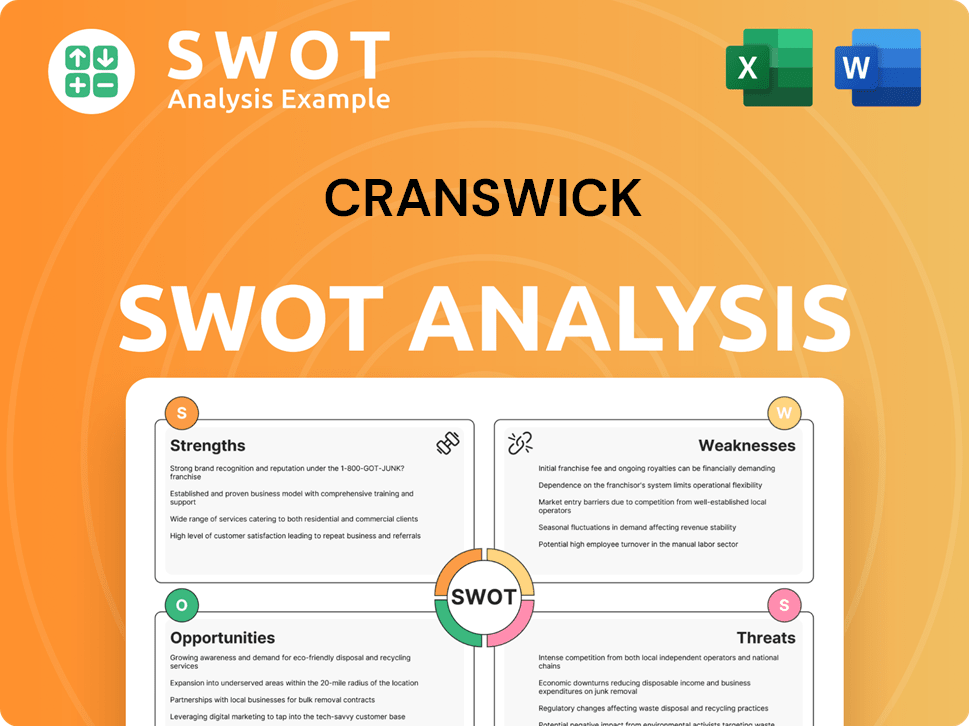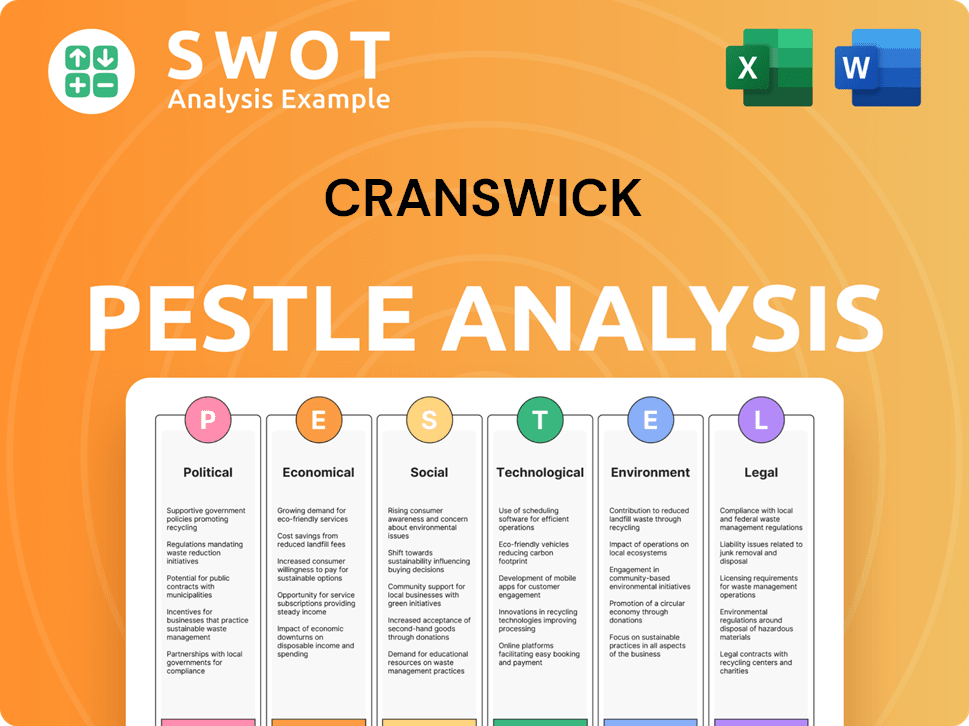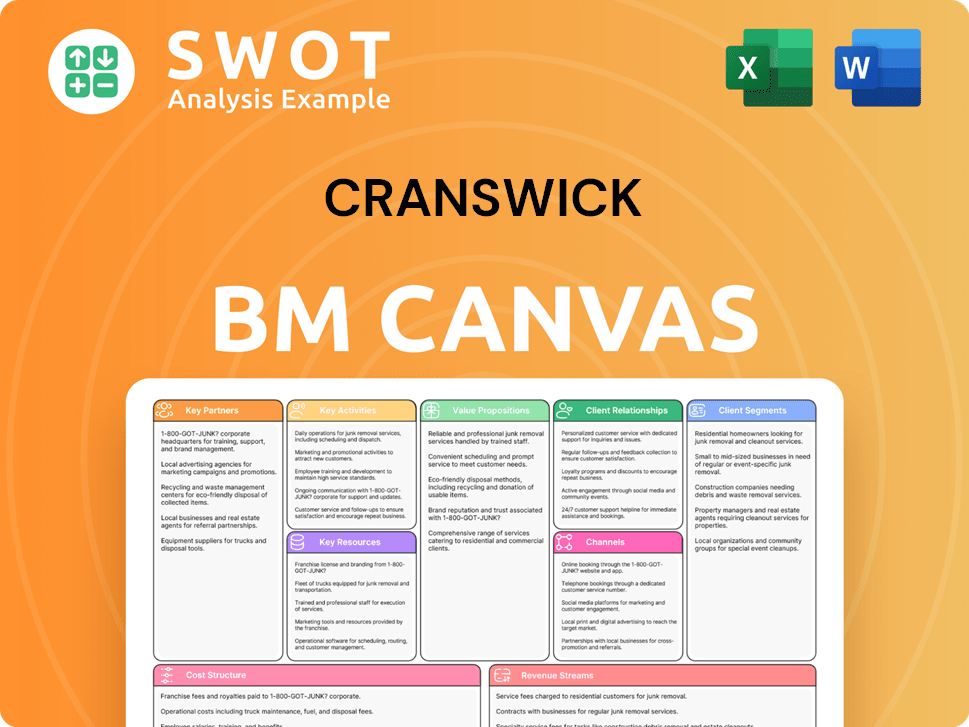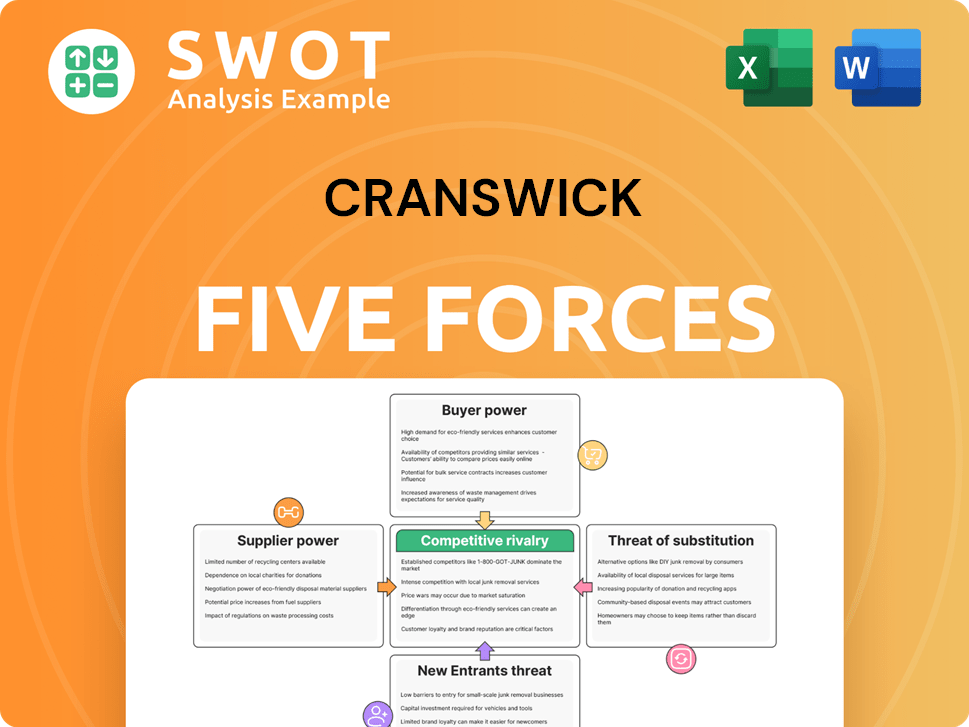Cranswick Bundle
Can Cranswick Navigate the Complexities of the Food Industry?
The food industry is a battlefield, constantly reshaped by consumer tastes and supply chain pressures. Cranswick plc, a major player in the UK's meat and convenience food sectors, has been adapting to these changes. Their commitment to sustainable farming and plant-based alternatives hints at a dynamic strategy, making it crucial to understand their position.

From its origins as a pig farm in 1970, Cranswick has evolved into a FTSE 250 company, demonstrating remarkable growth through strategic moves. This Cranswick SWOT Analysis will help you understand the Cranswick competitive landscape. This comprehensive Cranswick market analysis will explore its key rivals, competitive advantages, and the broader food industry competition, offering actionable insights for investors and strategists alike. Understanding Cranswick's position in the UK meat market requires a deep dive into its business strategy overview, including its recent acquisitions and innovation in meat processing.
Where Does Cranswick’ Stand in the Current Market?
Cranswick plc holds a strong market position within the UK food industry, particularly in the pork and convenience food sectors. The company is a leading supplier to major UK retailers, indicating a significant share of the retail meat market. Its core operations involve the processing and supply of fresh pork, sausages, bacon, cooked meats, poultry, and gourmet convenience foods.
Cranswick's value proposition centers on providing high-quality, value-added meat products and convenience foods to a diverse customer base. This includes supermarkets, discounters, and the food service sector. Its integrated supply chain, from farm to fork, is a key competitive advantage, ensuring product quality and efficiency. The company's strategic shift towards a broader range of value-added and convenience products allows it to meet changing consumer demands.
Cranswick's financial performance reflects its strong market position. For the year ending March 2024, Cranswick reported a revenue of approximately £2.6 billion, demonstrating a year-on-year increase of 11.9%. The adjusted profit before tax for the same period was £162.7 million, up 14.8%. This financial health, combined with a robust balance sheet, positions Cranswick favorably within the meat processing industry.
Cranswick is a leading supplier to major UK retailers, holding a significant share in the retail meat market. While specific market share data for 2024-2025 isn't readily available, its prominence in the sector is well-established. The company's focus on pork and convenience foods contributes significantly to its market presence.
Cranswick's product range includes fresh pork, sausages, bacon, cooked meats, poultry, and gourmet convenience foods. This diverse portfolio allows it to cater to a wide range of consumer preferences and market segments. The company continually innovates to meet evolving consumer demands.
Cranswick's primary geographic focus is the United Kingdom, where it operates numerous production facilities. It serves a broad customer base, including supermarkets, discounters, and the food service sector. This concentrated presence allows for efficient operations and strong relationships.
In the year ending March 2024, Cranswick reported a revenue of approximately £2.6 billion, with an adjusted profit before tax of £162.7 million. This strong financial performance underscores its robust market position and effective business strategies. The company's financial health is a key factor in its competitive advantage.
Cranswick's competitive advantages include its integrated supply chain and strong relationships with major UK retailers. Its focus on value-added products and convenience foods allows it to adapt to changing consumer preferences. The company's financial stability further strengthens its position in the meat processing industry.
- Integrated supply chain from farm to fork.
- Strong relationships with major UK retailers.
- Diversified product portfolio including value-added and convenience items.
- Consistent financial performance with revenue growth.
To further understand Cranswick's strategic direction, particularly its growth strategy, you can refer to this article: Growth Strategy of Cranswick. This provides additional insights into the company's market approach and future plans.
Cranswick SWOT Analysis
- Complete SWOT Breakdown
- Fully Customizable
- Editable in Excel & Word
- Professional Formatting
- Investor-Ready Format

Who Are the Main Competitors Challenging Cranswick?
Understanding the Cranswick competitive landscape is crucial for assessing its position within the meat processing and food industry. This involves a detailed Cranswick market analysis to identify key rivals and evaluate their strategies. The competitive environment is dynamic, influenced by factors such as consumer preferences, economic conditions, and technological advancements.
Cranswick plc operates in a sector characterized by intense competition. The company faces a variety of challenges, including fluctuating commodity prices, evolving consumer tastes, and the rise of alternative protein sources. Analyzing these factors provides insights into Cranswick's strengths and weaknesses analysis and informs strategic decision-making.
The Cranswick competitive landscape is shaped by both direct and indirect competitors. Direct competitors include major food producers and processors in the meat sector, while indirect competition comes from companies offering plant-based alternatives. The following sections detail the key players and competitive dynamics.
Key direct competitors include large-scale food producers and processors. These companies often have significant market share and established distribution networks. They compete with Cranswick on factors such as price, product range, and supply chain efficiency.
Tulip Ltd., part of Pilgrim's Pride Corporation, is a major pig producer and processor in the UK. It offers a wide range of pork products to retail and foodservice customers. The company's extensive operations and distribution capabilities make it a significant competitor to Cranswick.
Karro Food Group, now part of Pilgrim's Pride, is another key competitor. It has substantial operations in pork processing and supply to UK supermarkets. The consolidation within Pilgrim's Pride has created a larger, more integrated competitor.
In the poultry segment, Cranswick competes with major players that have strong market positions. These companies often compete on price, brand recognition, and the ability to meet large-volume demands from major retailers. The poultry market is highly competitive.
Moy Park, also part of Pilgrim's Pride Corporation, is a dominant player in the UK chicken market. It offers a wide range of fresh and processed poultry products. The company's scale and market presence make it a significant competitor.
2 Sisters Food Group is another major competitor in the UK chicken market. It competes with Cranswick by offering a variety of fresh and processed poultry products. The company's ability to meet large-volume demands is a key competitive factor.
For convenience foods, Cranswick faces competition from a broader array of food manufacturers. This segment includes ready meals, sandwiches, and other prepared foods. Competition is driven by consumer demand for convenient food options.
The rise of plant-based alternatives presents an indirect but significant threat. Companies in this sector are vying for consumer spending in the protein market. This trend impacts Cranswick's traditional meat-centric business model.
Companies like Beyond Meat and Impossible Foods, along with numerous smaller UK-based plant-based producers, are key competitors. These companies are focused on capturing market share in the protein market. The growth of this segment poses a challenge to traditional meat processors.
The Cranswick competitive landscape is constantly evolving, influenced by mergers and acquisitions, consumer trends, and economic factors. Understanding these dynamics is crucial for developing effective business strategies. For example, the consolidation within the Pilgrim's Pride group has created larger, more integrated rivals. Cranswick's response to these challenges involves innovation, strategic acquisitions, and a focus on operational efficiency. To gain a deeper understanding of Cranswick's strategic initiatives, consider reading the Growth Strategy of Cranswick.
- Market Share Analysis: Analyzing Cranswick's company market share analysis compared to its competitors provides insights into its competitive position.
- Competitive Advantages and Disadvantages: Identifying Cranswick's competitive advantages and disadvantages helps in formulating strategies to enhance its market position.
- Future Outlook and Market Trends: Assessing Cranswick's future outlook and market trends, including the growth of plant-based alternatives, is essential for long-term planning.
- Supply Chain and Competitive Advantage: Examining Cranswick's supply chain and competitive advantage helps in understanding its operational efficiency and cost structure.
Cranswick PESTLE Analysis
- Covers All 6 PESTLE Categories
- No Research Needed – Save Hours of Work
- Built by Experts, Trusted by Consultants
- Instant Download, Ready to Use
- 100% Editable, Fully Customizable

What Gives Cranswick a Competitive Edge Over Its Rivals?
Examining the Cranswick competitive landscape reveals a company distinguished by its strategic advantages within the meat processing industry. Cranswick plc leverages a vertically integrated supply chain, brand reputation, and operational efficiencies to maintain a strong market position. This approach allows for greater control over quality and cost, contributing to its ability to offer premium products and build lasting customer relationships.
Cranswick's success is rooted in its ability to adapt and innovate. The company continuously invests in its production facilities to optimize processes and improve product innovation. This focus on efficiency and product development is crucial in a dynamic market. Furthermore, Cranswick is actively involved in sustainability initiatives, which enhance its brand image and appeal to environmentally conscious consumers, a key factor in today's market.
Understanding the Cranswick competitive landscape involves assessing its strengths and weaknesses relative to its competitors. The company's integrated supply chain, brand equity, and operational efficiencies provide a solid foundation. However, it faces challenges from competitors and industry shifts, requiring continuous adaptation and innovation to maintain its competitive edge. For more information about the company's ownership structure, you can read Owners & Shareholders of Cranswick.
Cranswick's vertically integrated supply chain, especially in pork production, is a key strength. This integration provides control over quality, traceability, and cost. The company owns and manages pig farming operations and feed mills. This allows for a consistent supply of high-quality raw materials and quick responses to market demands.
Cranswick has built a strong reputation for quality and reliability. It has fostered long-term relationships with major UK supermarkets. This trust is supported by consistent product quality and adherence to high standards of food safety and animal welfare. The company's commitment to sustainability further enhances its brand image.
Cranswick continuously invests in its production facilities. This optimizes processes, reduces waste, and improves product innovation. The company's investment in advanced manufacturing technologies allows for the efficient production of a diverse range of products. This focus on efficiency is crucial for maintaining a competitive edge.
Cranswick's commitment to sustainability, including investments in renewable energy and responsible sourcing, enhances its brand image. This commitment appeals to environmentally conscious consumers. The company's focus on sustainable practices is increasingly important in the food industry.
Cranswick's competitive advantages are rooted in its integrated operations, brand reputation, and strategic focus. These advantages contribute to its ability to offer premium products and maintain competitive pricing. The company's ongoing investment in innovation and diversification, including its move into plant-based foods, demonstrates its strategy to sustain and evolve these advantages.
- Vertically Integrated Supply Chain: Controls quality and cost.
- Strong Brand Reputation: Builds customer loyalty.
- Operational Efficiencies: Drives production optimization.
- Sustainability Initiatives: Enhances brand image.
Cranswick Business Model Canvas
- Complete 9-Block Business Model Canvas
- Effortlessly Communicate Your Business Strategy
- Investor-Ready BMC Format
- 100% Editable and Customizable
- Clear and Structured Layout

What Industry Trends Are Reshaping Cranswick’s Competitive Landscape?
The Cranswick competitive landscape is significantly influenced by evolving industry trends and consumer preferences. The company, Cranswick plc, navigates a dynamic market characterized by increasing demand for sustainable practices and technological advancements. This requires strategic adaptation to maintain and enhance its market position within the meat processing industry and broader food industry competition.
Understanding Cranswick's market analysis necessitates an examination of both the challenges and opportunities it faces. Economic shifts, regulatory changes, and the rise of plant-based alternatives present potential hurdles. However, strategic investments in sustainability, technological innovation, and diversification position Cranswick to capitalize on emerging trends and maintain a competitive edge.
The food industry is experiencing a shift towards sustainable and ethical practices. Consumers are increasingly concerned about animal welfare, environmental impact, and transparent sourcing. Cranswick's 'Farm to Fork' strategy is designed to meet these demands.
Automation and data analytics are becoming crucial in food processing. These technologies offer opportunities for increased efficiency, improved quality control, and product innovation. E-commerce and direct-to-consumer models also present growth opportunities.
Global economic shifts, including inflationary pressures, can impact raw material costs and consumer spending. Increased regulation related to food safety, environmental standards, and animal welfare could also impose additional operational costs. The rise of plant-based alternatives presents a long-term challenge.
Investing in sustainable farming and reducing its carbon footprint can strengthen its brand appeal. Diversifying into plant-based protein alternatives allows Cranswick to capture a share of the growing market. Strategic acquisitions and partnerships, as seen in 2024, demonstrate a proactive approach.
Cranswick's strategic focus includes investments in sustainability, technological innovation, and diversification. The company aims to maintain its resilience and capitalize on emerging opportunities in the food industry. Understanding Cranswick's strengths and weaknesses analysis is key to grasping its market position.
- Integrated Supply Chain: Cranswick's integrated supply chain provides a competitive advantage.
- Customer Relationships: Strong customer relationships are crucial for market success.
- Adaptability to Consumer Trends: The company must remain adaptable to evolving consumer preferences.
- Growth Strategy: For more insights into the financial aspects, consider exploring Revenue Streams & Business Model of Cranswick.
Cranswick Porter's Five Forces Analysis
- Covers All 5 Competitive Forces in Detail
- Structured for Consultants, Students, and Founders
- 100% Editable in Microsoft Word & Excel
- Instant Digital Download – Use Immediately
- Compatible with Mac & PC – Fully Unlocked

Related Blogs
- What are Mission Vision & Core Values of Cranswick Company?
- What is Growth Strategy and Future Prospects of Cranswick Company?
- How Does Cranswick Company Work?
- What is Sales and Marketing Strategy of Cranswick Company?
- What is Brief History of Cranswick Company?
- Who Owns Cranswick Company?
- What is Customer Demographics and Target Market of Cranswick Company?
Disclaimer
All information, articles, and product details provided on this website are for general informational and educational purposes only. We do not claim any ownership over, nor do we intend to infringe upon, any trademarks, copyrights, logos, brand names, or other intellectual property mentioned or depicted on this site. Such intellectual property remains the property of its respective owners, and any references here are made solely for identification or informational purposes, without implying any affiliation, endorsement, or partnership.
We make no representations or warranties, express or implied, regarding the accuracy, completeness, or suitability of any content or products presented. Nothing on this website should be construed as legal, tax, investment, financial, medical, or other professional advice. In addition, no part of this site—including articles or product references—constitutes a solicitation, recommendation, endorsement, advertisement, or offer to buy or sell any securities, franchises, or other financial instruments, particularly in jurisdictions where such activity would be unlawful.
All content is of a general nature and may not address the specific circumstances of any individual or entity. It is not a substitute for professional advice or services. Any actions you take based on the information provided here are strictly at your own risk. You accept full responsibility for any decisions or outcomes arising from your use of this website and agree to release us from any liability in connection with your use of, or reliance upon, the content or products found herein.